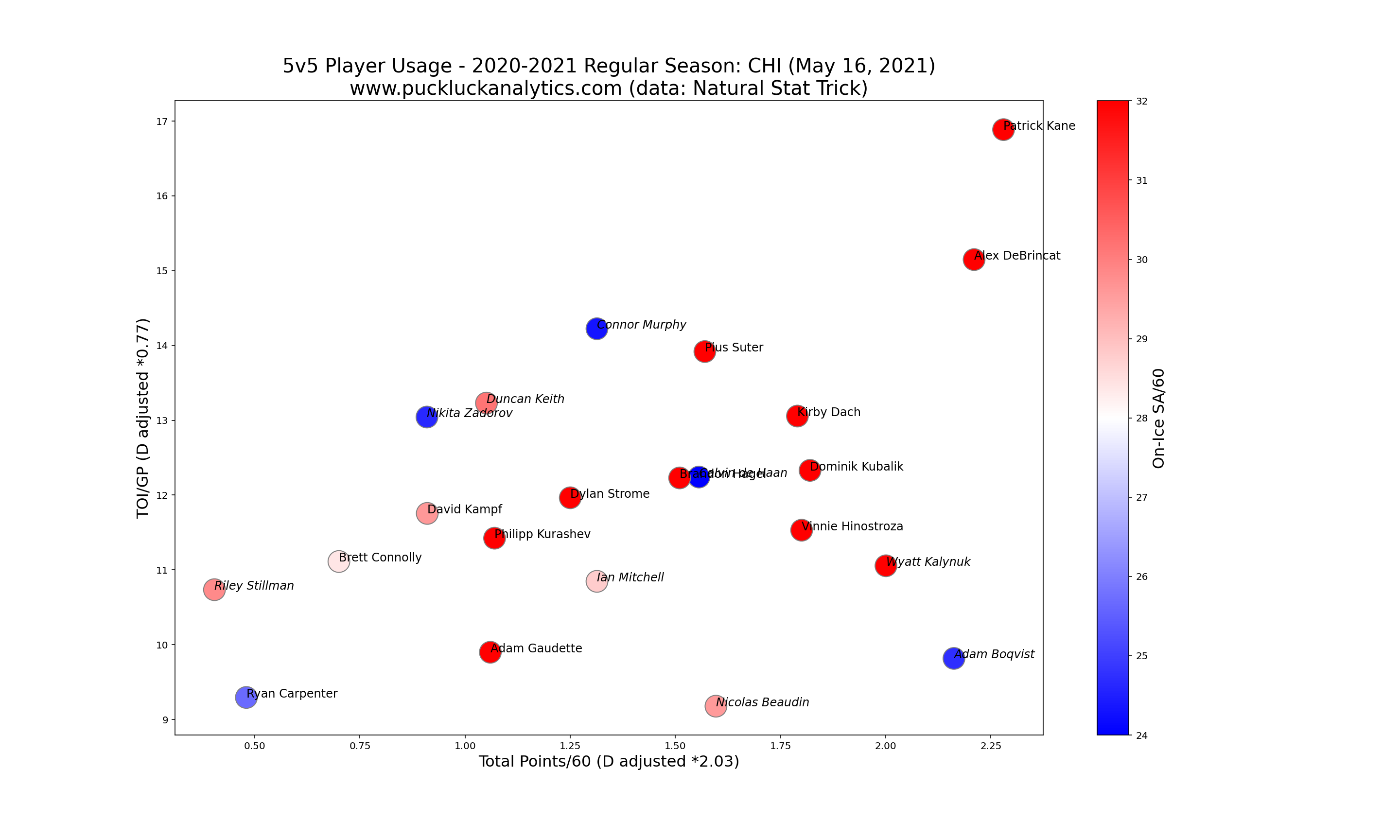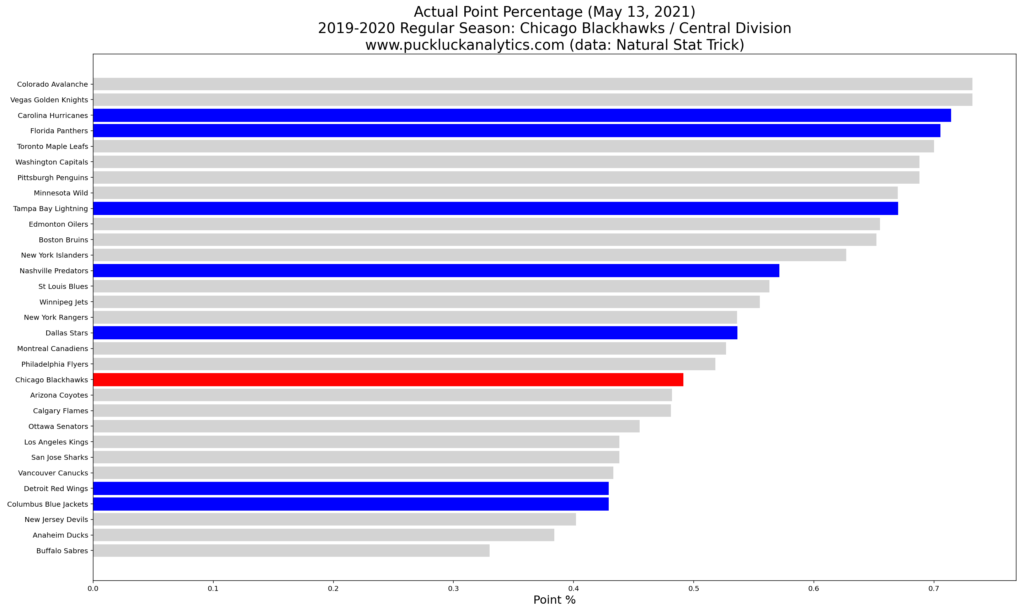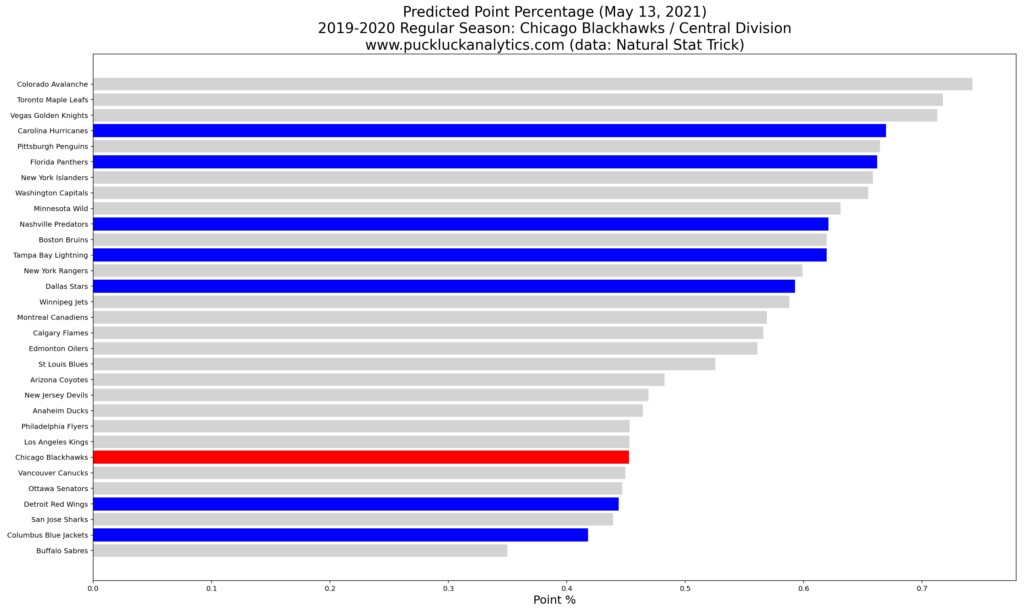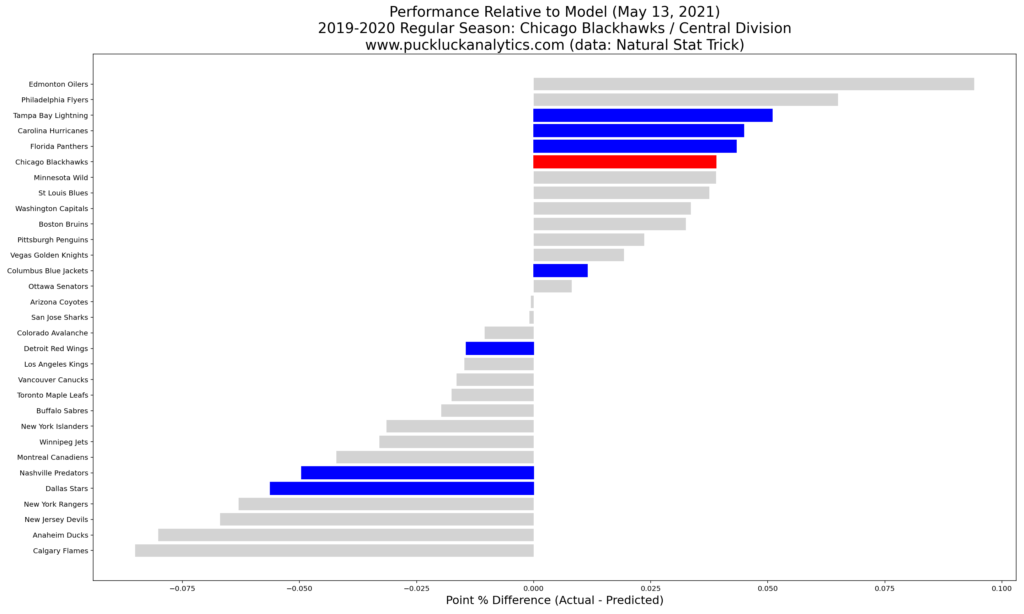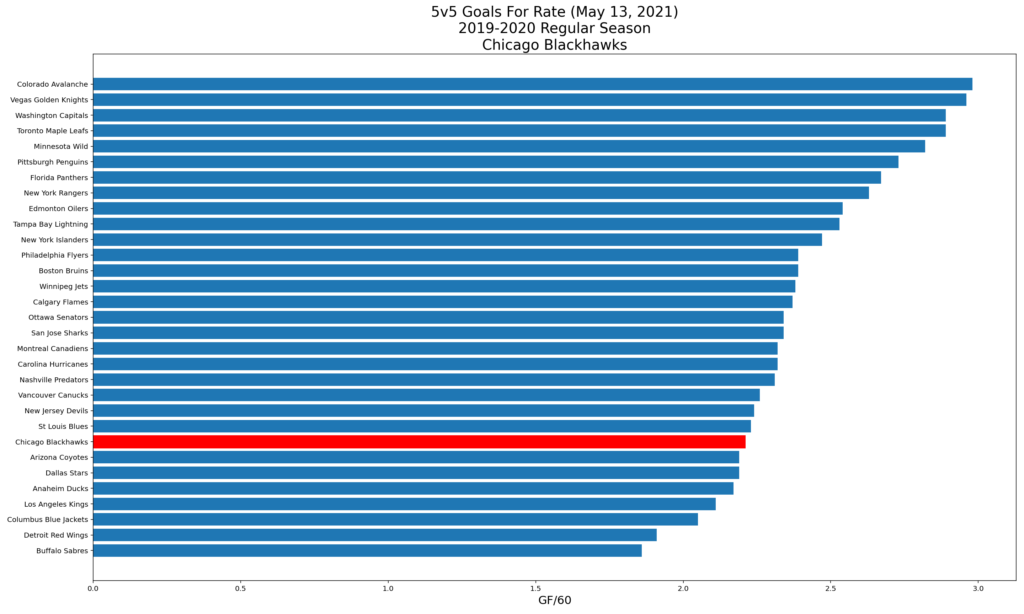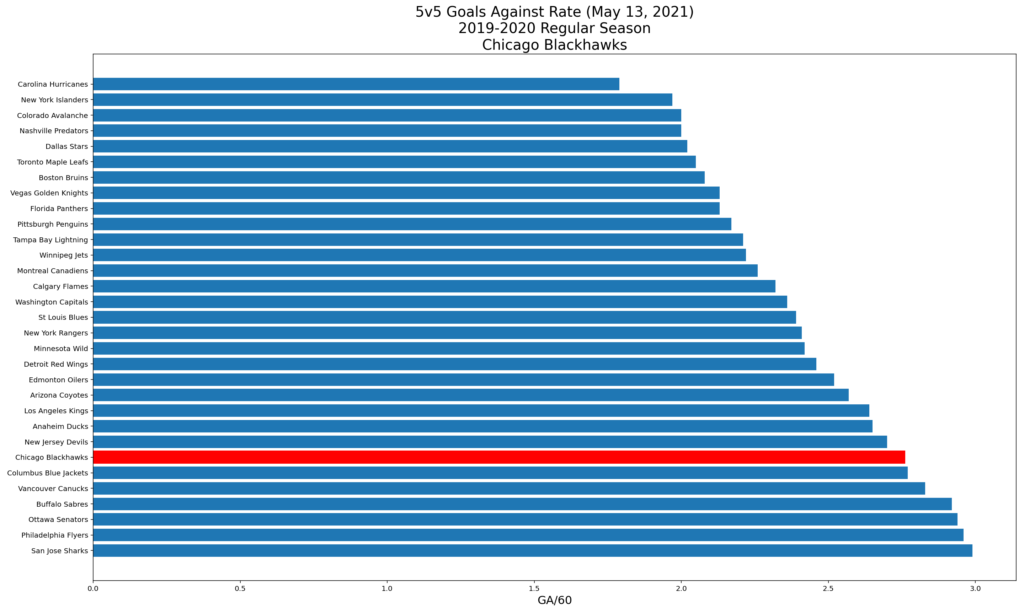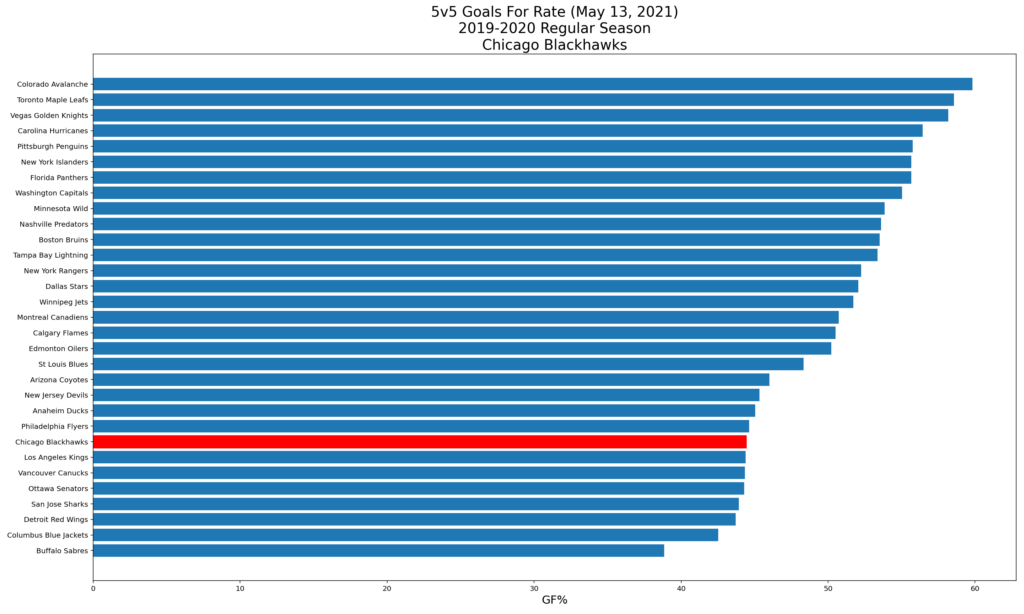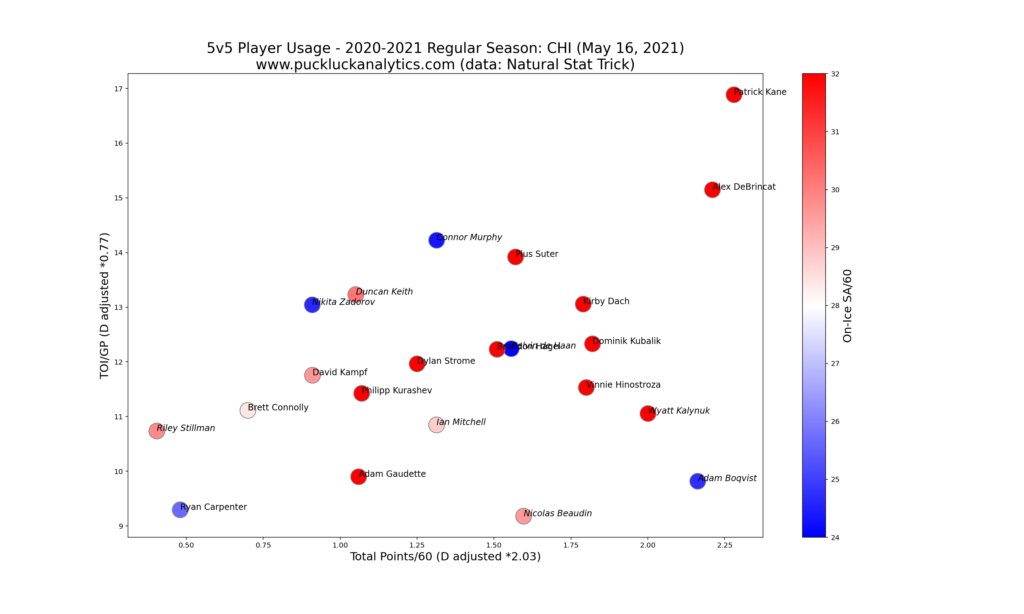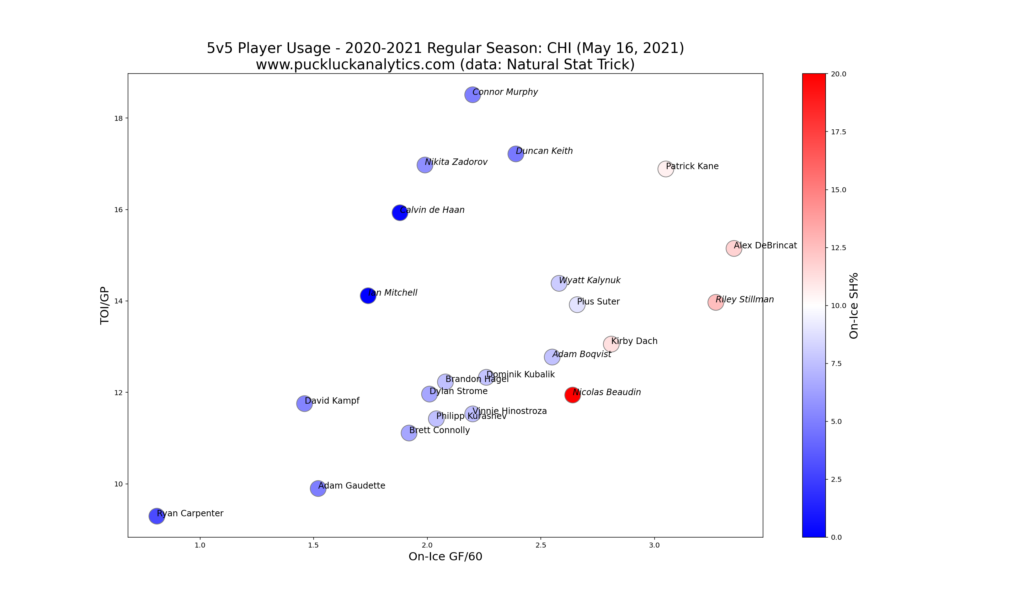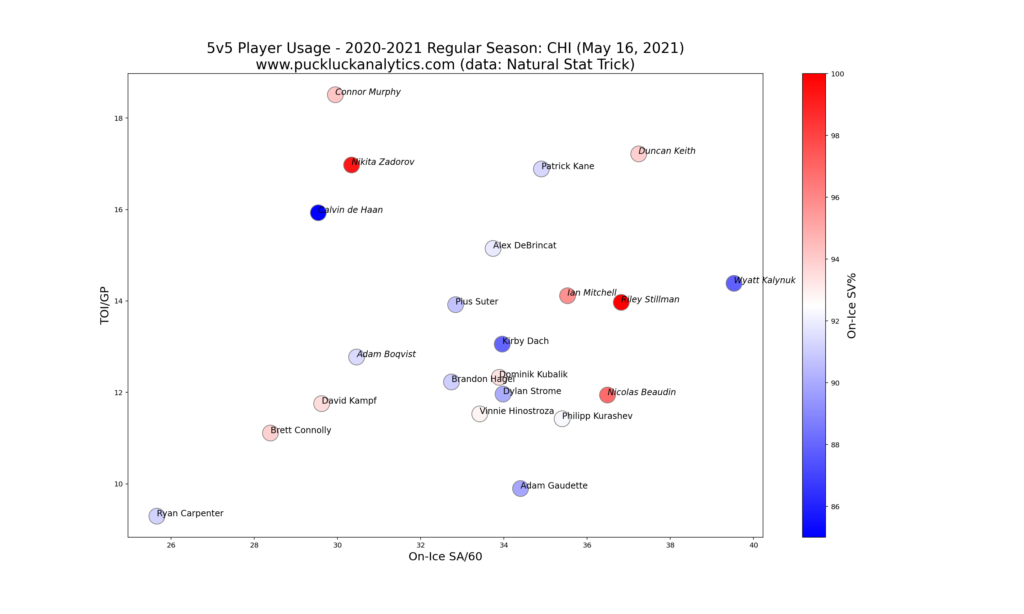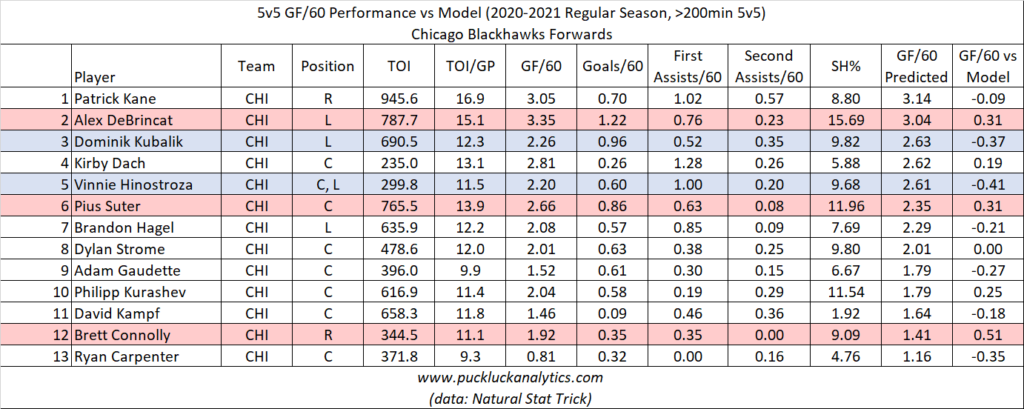The Chicago Blackhawks had a hot start to the 2020-2021 season, but ultimately fell out of the playoff picture. Today, I’m taking a look at the Blackhawks season. I recommend taking a look at this post that outlines some of the things I’m looking for in more detail.
Overall Performance
The Blackhawks hung in the playoff race well into the season but ultimately couldn’t keep pace with a resurgent Predators team in the second half. In the end, they finished in 6th place in the Central Division. Let’s take a closer look at their results, as well as where our point predictor model put them using 5v5 data.
The Hawks significantly outperformed the points predictor model, indicating that their success this season was not entirely driven by their 5 on 5 play. Other factors, such as special teams or overtime results, are the likely behind the discrepancy. Since these other factors tend to be quite variable from season to season, we expect the Hawks may regress next season without improvements to the roster.
Let’s take a look at the 5v5 goal rates that feed the model.
Looking at the Hawks’ 5v5 goal rates, neither offense or defense stands out as a more pressing issue that they need to address. Instead, they should focus on making balanced improvements over the offseason.
Player Performance
We’ll start evaluating player performance by looking at a usage chart. I’ve adjust defensemen stats for comparison with forwards and the resulting chart gives us a visual depth chart starting from the top right and continuing on the diagonal down to the bottom left.
Patrick Kane and Alex DeBrincat immediately jump out as the Hawks best players. The significant spread off the diagonal for the defensemen also jumps out. It looks like Duncan Keith, Nikita Zadorov, and Connor Murphy were over-utilized while Adam Boqvist and Wyatt Kalynuk were under-utilized. Given the much higher offensive production from the latter two D-men, it looks like they should be given a larger opportunity upon first glance.
We get a visual depiction of each player’s impact on team GF/60 by plotting on-ice GF/60 against TOI/GP. The further toward the top right, the greater contribution a player had to team GF/60.
It’s clear again that Kane and DeBrincat were the Hawks’ most dangerous players this year. Puis Suter and Kirby Dach provided some secondary offense and the rest of the forwards are grouped quite closely with more limited impact. It’s clear the Blackhawks need an upgrade to their top six forward group. The defensemen seem to be utilized less than optimally based on offensive impact. The defensemen with the top 3 on-ice GF/60 battled for bottom pairing ice time.
Let’s take a similar look at defensive impact. This time, players closer to the bottom left contributed more positive impacts to overall team defense.
Duncan Keith jumps out here with a less than stellar impact on team defense. At age 37, he is at the tail end of his career it looks like the Blackhawks would be best served by giving him a smaller role. We saw earlier that Adam Boqvist had a solid offensive impact this season and his defensive impact is among the best on the team. At only 20 years old, he looks like a player that could be a cornerstone forward for the Blackhawks.
Let’s jump to our on-ice GF/60 model. Here, we are looking for large discrepancies between actual and predicted numbers that may indicate some changes in player usage would be beneficial. We’ll start with the forwards.
While DeBrincat and Suter had some of the largest positive variances from the model, their shooting percentages were both on the high side this year and we can expect some regression. Since the model uses goals as an input, the model prediction is likely on the high side and the variance may actually be larger. This suggests that these players may have been carried by their line mates offensively and may see some regression next year. Both players played large amounts of their 5 on 5 time with Patrick Kane (70% for DeBrincat, closer to 60% for Suter). While they performed well this year, the model results may be an indication that they are not yet ready to anchor their own line with the level of success.
On the flip side, Hinostroza and Kubalik underperformed the model by significant margins. Given their relatively average shooting percentages, it looks like they carried their line mates to some degree.
Calvin de Haan and Ian Mitchell were the biggest underperformers relative to the model among defensemen. This may have been a case of which forward lines they typically played with. The Hawks should look for ways to deploy them to maximize their offensive impact since the model suggests they can have a larger impact. Meanwhile, we see another sign that Duncan Keith’s age is starting to show. He overperformed the model, suggesting that his line mates carried him offensively. Keith played only about 30% of his 5v5 time with Patrick Kane, so we don’t have the same explanation we did with DeBrincat and Suter for the discrepancy.
Rookie Kevin Lankinen was a bright spot in Chicago this year. His strong play was a large part of the reason that Chicago hung with the playoff teams through the early part of the season. Provided his strong play carries over into next season, the Hawks look set in the crease.
Looking Ahead
The Blackhawks have over $76M in cap space already tied up for next season. With only a handful of free agents, the roster will likely look fairly similar next season unless they can tap into the trade market in the offseason and move some salary out.
Key RFAs:
Puis Suter is headed for restricted free agency this summer. We saw him stand out as one of the Hawks’ more impactful offensive players and the Hawks will want him to continue to be a leader within their offense. On defense, Nikita Zadorov will also be an RFA. With cap space tight, the Hawks will be looking for an affordable deal.
Key UFAs:
Vinnie Hinostroza and Zack Smith are the only Hawks headed for unrestricted free agency this offseason. We saw some positive signs from Hinostroza in our review, but the Hawks will likely be able to fill both holes with young players or affordable free agents.
Key Players Under Contract:
Jonathan Toews and Patrick Kane remain signed for another two seasons at $10.5M per season each. As we saw in our review, it appeared Kane had a positive impact on his young line mates. With Toews status for next season still unclear, the Blackhawks will continue to lean on Kane while their younger players develop.
Tough Questions:
With the core that brought the Blackhawks two Stanley Cups showing their age, it’s time for the Hawks youth movement to start taking over. Brent Seabrook announced his retirement this season and Toews status is still unclear. What does the future hold for Toews, Kane and Keith? Is it time for the Blackhawks to move on from this group and clear some cap space? Can they find a trade partner for on or more of these players that could bring in additional young assets? With two years remaining at just over $5.5M for Keith, does a buyout make sense if the Hawks can’t find a trade partner?
Offseason Priority:
With little cap room to maneuver, the Hawks need to improve both offensively and defensively. Most of that improvement will have to come internally through the growth of their young players given their tight cap position. Adding a few good value free agents could also give them a boost.
Check out my other season reviews that are already up, such as the Detroit Red Wings and the Vancouver Canucks, and subscribe to catch the rest of the reviews as they come out.
data: Natural Stat Trick
cap data: CapFriendly
